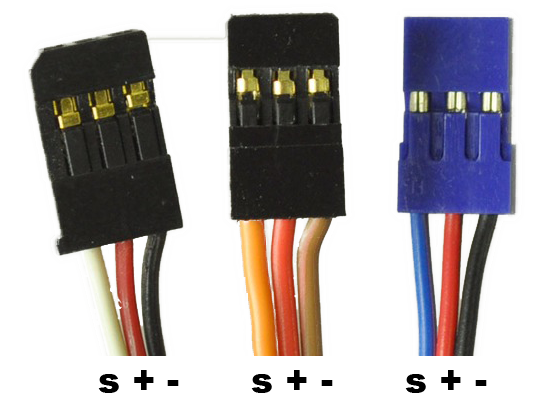Some of the in’s and out’s of Servo Wiring…
About 1991 or soon after, most of the major brands of analog servos became compatible with each other. When this happened, you can use any of these brands of servos with any brand of receiver, but you must be careful about the polarity of the wiring. Some brands of servos are really great for a particular use in a particular plane, and there are other companies that sell their servos with each different manufacturer’s connector installed (you just have to ask for what you want).
You can mix Futaba servos with an Airtronics receiver, mix Hitec & JR servos with a Futaba receiver, etc. as long as you are careful about polarity. In Futaba, Hitec, and JR Radio servos, the servo and battery connections have the same polarity (+/-) and signal wiring, although the connectors are slightly different.
One thing to remember: You can’t reverse the direction of a servo (reversed servo) by just swapping (+) and (-) wires. If you do, you’ll burn out either the servo or the receiver or both. Reversing of a servo direction is done a the transmitter, any transmitter nowadays can do that.

Lots of people are now asking, “What is the difference between analog and digital servos?”
The motor of an analog servo receives a signal from the servo amplifier (inside the servo) at 30 times a second. This pulsing signal tells the servo motor when to start rotating and which way to rotate. Since it only happens 30 times a second, that’s the minimum reaction time. Digital servos use a higher frequency amplifier that sends a signal to the servo motor 300 times a second (or sometimes more on very fast servos, such as those used for helicopter tail rotors). Since this signal is received by a digital servo’s motor more often, it is able to react much faster and hold its position better. This means the servo has better centering and considerably higher holding power. This power comes at a cost, however, as digital servos tend to draw a lot more power from the on-board battery which means your battery just won’t last as long.
There are also different types of servo motors available: cored, coreless, and now brushless.

